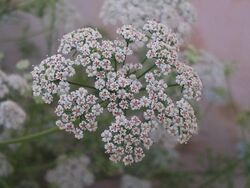Biology:Ajwain
| Ajwain | |
|---|---|

| |
| Flowers of Trachyspermum ammi | |
| Scientific classification | |
| Kingdom: | Plantae |
| Clade: | Tracheophytes |
| Clade: | Angiosperms |
| Clade: | Eudicots |
| Clade: | Asterids |
| Order: | Apiales |
| Family: | Apiaceae |
| Genus: | Trachyspermum |
| Species: | T. ammi
|
| Binomial name | |
| Trachyspermum ammi (L.) Sprague ex Turrill
| |
| Synonyms[1][2] | |
Ajwain or ajowan (Trachyspermum ammi) [3] (/ˈædʒəwɒn/) —also known as ajowan caraway, omam (in Tamil), thymol seeds, bishop's weed, or carom—is an annual herb in the family Apiaceae.[4] Both the leaves and the seed‑like fruit (often mistakenly called seeds) of the plant are consumed by humans. The name "bishop's weed" also is a common name for other plants. The "seed" (i.e., the fruit) is often confused with lovage seed.[5]
Description
Ajwain's small, oval, seed-like fruits are pale brown schizocarps, which resemble the seeds of other plants in the family Apiaceae such as caraway, cumin and fennel.[6] They have a bitter and pungent taste, with a flavor similar to anise and oregano. They smell like thyme because they also contain thymol, but they are more aromatic and less subtle in taste, as well as being somewhat bitter and pungent.[6] Even a small number of fruits tend to dominate the flavor of a dish.[5]
Cultivation and production
Ajwain grows in dry, barren soil in its indigenous regions of India, Iran, Afghanistan, and parts of northern Africa.[6] Gujarat and Rajasthan are regions in India well-known for cultivating ajwain.[7]
Culinary uses
The fruits are rarely eaten raw; they are commonly dry-roasted or fried in ghee (clarified butter). This allows the spice to develop a more subtle and complex aroma. It is widely used in the cuisine of the Indian subcontinent, often as part of a chaunk (also called a tarka), a mixture of spices – sometimes with a little chopped garlic or onion – fried in oil or clarified butter, which is used to flavor a dish at the end of cooking. It is also an important ingredient for herbal medicine practiced there. In Nepal, Jwano Ko Jhol- brothy soup of ajwain, has been in traditional cuisine that is mostly consumed to recover from respiratory problems, and during postpartum recovery. In Afghanistan, the fruits are sprinkled over bread and biscuits.[8] Ajwain is also an important component of spice mixtures in Ethiopian food.
Other applications of ajwain include incorporating the seeds in specific types of breads, such as naans and parathas. The seeds can also be used as a mouth freshener when mixed with lemon juice and black pepper and then dried or can simply be used as an ingredient in hot tea.[6]
In herbalism
Ajwain is used in herbalism practices, such as Ayurveda, in the belief that it can treat various disorders.[6][9] However, there is no good evidence that ajwain is effective as a therapy for treating any disease.[6]
Adverse effects
Pregnant women should avoid ajwain due to potential adverse effects on fetal development, and its use is discouraged while breastfeeding.[6] In high amounts taken orally, ajwain can result in fatal poisoning.[6] People taking nonsteroidal anti-inflammatory drugs or antiplatelet medications are susceptible to adverse effects from ajwain ingestion, as ajwain has anti-clotting activity of its own.[6]
Essential oil
Hydrodistillation of ajwain fruits yields an essential oil consisting primarily of thymol, gamma-terpinene, p-cymene, and more than 20 trace compounds which are predominantly terpenoids.[6][10]
References
- ↑ {{citation | mode = cs1 | title = Ajwain | work = Germplasm Resources Information Network (GRIN) | url = | publisher = [[Organization:Agricultural Research ServAgricultural Research Service (ARS), United States Department of Agriculture (USDA) | access-date = 11 December 2017 }}
- ↑ ITIS entry for Trachyspermum ammi
- ↑ "ajowan - Definition of ajowan in English by Oxford Dictionaries". http://www.oxforddictionaries.com/definition/english/ajowan.
- ↑ "Ajwain". Digital Herbarium of Crop Plants. 4 October 2016. http://dhcrop.bsmrau.net/ajwain/?doing_wp_cron=1614963208.0756139755249023437500.
- ↑ 5.0 5.1 Aliza Green (January 2006). Field Guide to Herbs & Spices: How to Identify, Select, and Use Virtually Every Seasoning at the Market. Quirk Books. pp. 116–117. ISBN 978-1-59474-082-4. https://archive.org/details/fieldguidetoherb0000gree.
- ↑ 6.0 6.1 6.2 6.3 6.4 6.5 6.6 6.7 6.8 6.9 "Bishop's weed". Drugs.com. 29 July 2022. https://www.drugs.com/npp/bishop-s-weed.html.
- ↑ Bairwa, Ranjan; Sodha, R. S.; Rajawat, B. S. (2012). "Trachyspermum ammi". Pharmacognosy Reviews 6 (11): 56–60. doi:10.4103/0973-7847.95871. ISSN 0973-7847. PMID 22654405.
- ↑ Alan Davidson (2014). The Oxford Companion to Food. Oxford University Press. pp. 9–. ISBN 978-0-19-967733-7. https://books.google.com/books?id=RL6LAwAAQBAJ&pg=PA9.
- ↑ Duke, James A. (2002). Handbook of medicinal herbs. Duke, James A., 1929- (2nd ed.). Boca Raton, FL: CRC Press. ISBN 978-0849312847. OCLC 48876592.
- ↑ Singh, Gurdip; Maurya, Sumitra; Catalan, C.; de Lampasona, M. P. (June 2004). "Chemical Constituents, Antifungal and Antioxidative Effects of Ajwain Essential Oil and Its Acetone Extract". Journal of Agricultural and Food Chemistry 52 (11): 3292–3296. doi:10.1021/jf035211c. PMID 15161185.
Wikidata ☰ Q413254 entry
 |


